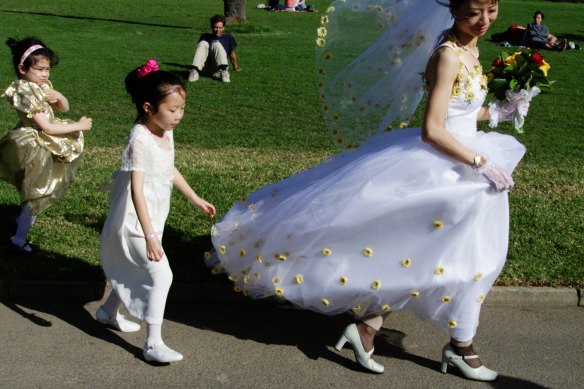By Matt Wade
One in seven Australian adults now has a de facto partner following a sharp decline in marriages among those aged under 35.
The Household, Income and Labour Dynamics in Australia (HILDA) survey, which has tracked the same 9000 households since 2001, shows only 20.5 per cent of women aged 25-29 were married in 2021, down from 35.9 per cent in 2001. The latest HILDA study, released on Monday, highlights ways in which family life has changed over the past two decades. Here are four big trends revealed by the survey.

The share of Australians who are married has fallen by 6 percentage points over the past 20 years.Credit: Fairfax Media
Fewer marriages
In 2001, about 55 per cent of women aged over 18 were married. By 2019 that share had fallen below 50 per cent and reached 48.2 per cent by 2021. Meanwhile, the share of women in a de facto relationship has climbed from 8.9 per cent in 2001 to 14.3 per cent.
The share of married men has dropped by a similar amount to women over the past two decades but was a little higher in 2021 at 50.3 per cent.
Overall, the share of Australians who are legally married has fallen by about 6 percentage points over the past 20 years.
While de facto couples have become more common, the HILDA survey shows people in the group are more likely to go through separation than married couples. Those with lower levels of education are more likely to separate from both marriages and de facto relationships. The unemployed also have a higher probability of experiencing a breakup in their romantic relationships compared to those who are employed.
The study found financial benefits to being in a romantic partnership but changing from partnered to single is worse for females, reducing their incomes by 16.7 per cent on average.
More workers
The growing share of women with a job means there are more workers than ever.
In 2001, about 64 per cent of women aged between 18 and 64 were employed, but that had jumped by 10 percentage points to 74 per cent by 2019.
The proportion of men with a job has hovered between 79 per cent and 83 per cent during the past 20 years.
Women are still much more likely to work part-time than men (33 per cent of women worked part-time in 2021 compared with 13 per cent for men). But the share of women with a full-time job has climbed from about 35 per cent to 40 per cent over the past 20 years.
Melbourne University’s Professor Roger Wilkins, who co-authored the report, said the gender pay gap in favour of male workers shown by the HILDA survey remained largely unchanged between 2001 and 2016, with women in full-time work receiving 78-79 per cent of what men in full-time work earned on average over that period. But since 2016 that gap has steadily narrowed – by 2021, women in full-time work earned 86 per cent of male full-time earnings on average.
In 2021, about 45 per cent of workers reported an entitlement to home-based work, up from 34.8 per cent in 2019. Wilkins said the acceptance of flexible employment, especially work from home since COVID-19, would “disproportionately benefit” female workforce participation “because women tend to take on the lion’s share of the workload in raising children”.
Young adults are lingering in the family home
The share of young adults aged 18-29 still living in the family home surged higher between 2001 and 2015 and has remained at record levels ever since.
In 2021, just over 54 per cent of men in that age cohort and nearly 47 per cent of women were residing with their parents.
Between 2001 and 2003, young men and women were equally likely to leave their parental home – 22.2 per cent for men and 19.4 per cent for women. But the proportion of men leaving home has since fallen sharply; to 14.9 per cent between 2018 and 2020. The HILDA survey shows young men also have a higher tendency to return to their parental home after leaving for a period.
The trend for 18-29-year-olds to linger in the family home is explained in part by young people spending more time in education and their leisure choices, especially a preference for overseas travel.
But high housing costs are another major factor. The HILDA survey shows young adults in expensive housing markets within NSW, Victoria and the ACT are less likely to leave home than those in other states.
Higher rates of psychological distress and loneliness
The HILDA survey shows rates of psychological distress have been on the rise, especially among young people. The latest survey found 42.3 per cent of 15-24 year-olds were psychologically distressed. That’s more than double the share in 2011 of 18.4 per cent.
The survey also revealed a striking shift in the prevalence of loneliness. Between 2001 and 2009, the highest proportion of lonely people was among those aged 65 and older. But since 2019 loneliness has been highest among younger Australians aged 15-24.
Melbourne University’s Dr Ferdi Botha, a report co-author, said there is a clear trend of younger people becoming lonelier and feeling more isolated.
“If there aren’t actions taken or policies implemented to intervene, we may see loneliness and psychological distress increasing in the younger generations and this may lead to lower mental and physical wellbeing and other wider societal issues,” he said. “Loneliness increased in the first two years of the COVID pandemic, but for young people, there is a longer-term trend apparent. This may be connected to growth in smartphone and social media use.”
Start the day with a summary of the day’s most important and interesting stories, analysis and insights. Sign up for our Morning Edition newsletter.